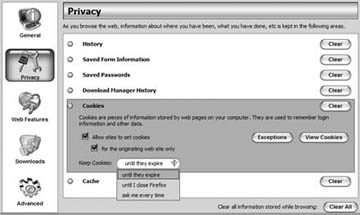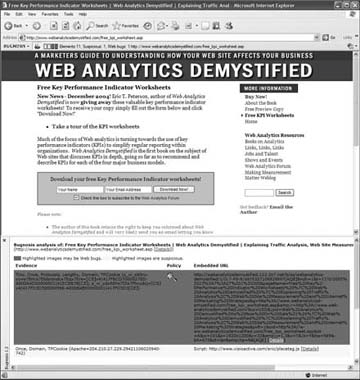Hack16.Know When to Use First-Party Cookies
Hack 16. Know When to Use First-Party Cookies
As consumers become more sensitive to potential invasions of their privacy, many are moving to limit your access to information about them via the use of cookies. Here's how to know when to use first-party cookies and what effect their use will have on your analysis. There are two kinds of persistent cookies used in web measurement: first and third party [Hack #15]. The answer to the question "When should I use a first-party cookie?" is basically "Whenever possible." In this era of increasing awareness about security and privacy, it is preferable to use first-party cookies over third-party cookies, period. It seems like rarely a week passes when we're not hearing about some other privacy intrusion or black hat hack; you and I may know that these intrusions rarely have anything to do with cookies, but the majority of Internet users have no clue. Given the popularity of anti-spyware applications and the simplicity with which third-party cookies can now be removed or blocked, it is no wonder that research is beginning to show that cross-visit accuracy for these types of cookies is slipping as low as 70 percent. Sure, 70 percent is a lot, but wouldn't you prefer 100 percent accuracy from your web measurement solution? Cookies are becoming increasingly easy to control, thanks to functionality built into the most popular browsers. Firefox has very simple tools for controlling what cookies are set, from where, and by whom (Figure 2-1) and Microsoft has provided strong controls for cookies via their implementation of the Platform for Privacy Preferences (P3P) [Hack #27]. As more and more Internet users learn about these kinds of tools, can the end of third-party cookies be far behind? 2.4.1. The Advantage of First-Party CookiesFirst-party cookies have many advantages. They are not subject to tightening default security settings in many of today's web browsers. They are also not likely to be deleted by anti-spyware and anti-adware programs, which go through your browser's cookies to delete any they deem to be spyware. Consequently, the accuracy of your web measurement data will be much higher if your analytics solution uses first-party cookies to track the majority of your web site activity. Figure 2-1. Changing cookies in Firefox 2.4.2. Third-Party Cookies Have Their PlaceWhile most measurement vendors support both first- and third-party cookies, it is important to note that third-party cookies do have their place. If you are interested in tracking your users as they navigate across multiple sites, it will be necessary to use third-party cookies. For example, suppose you manage two sister sites, www.lawnchairs.com and www.lawnfurniture.com, and you wish to track your users as they navigate across the two sites. Without third-party cookies, if a user clicks on a link from www.lawnchairs.com that takes them to www.lawnfurniture.com, your web measurement solution would track this as two separate visits. For sites in this situation, the best compromise is to find a web measurement vendor that uses first-party cookies for internal site activity and uses third-party cookies only to track users as they move from one site to the other. This way, you can use third-party cookies to follow users across your sites, but still retain the accuracy advantages of first-party cookies for all other activity. 2.4.3. How Can I Tell If I'm Using a First- or Third-Party Cookie?There are a handful of things you can do to determine whether your organization is using third-party cookies. Perhaps the easiest is to grab a copy of Bugnosis for Internet Explorer from www.bugnosis.org. Bugnosis is a great little plug-in for IE that will warn you when you're loading a web page that has any potential privacy violations embedded in it (Figure 2-2). Figure 2-2. Bugnosis report If you have an aversion to using Internet Explorer (as so many of us do) you can also do a simple search of your page's source code (View
You'll need to consult the overall privacy policies of your organization before deciding which type of cookie is ultimately best for you. Many financial and governmental institutions, for example, prohibit the use of third-party cookies, and many even prohibit the use of persistent first-party cookies. While third-party cookies have their place, it is best to avoid their use whenever possible. Xavier Casanova and Eric T. Peterson |
EAN: 2147483647
Pages: 157
 Page Source) for the following strings that identify the most common third-party cookies:
Page Source) for the following strings that identify the most common third-party cookies: